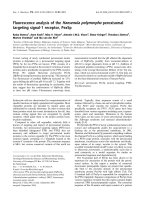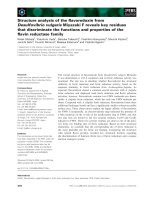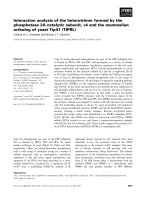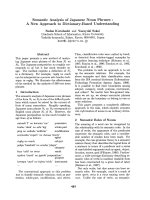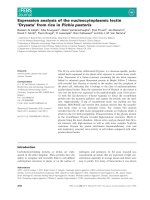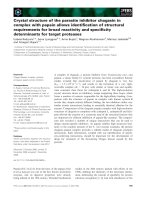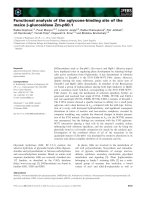báo cáo khoa học:" Quantitative analysis of the epithelial lining architecture in radicular cysts and odontogenic keratocysts" doc
Bạn đang xem bản rút gọn của tài liệu. Xem và tải ngay bản đầy đủ của tài liệu tại đây (870.59 KB, 9 trang )
BioMed Central
Page 1 of 9
(page number not for citation purposes)
Head & Face Medicine
Open Access
Research
Quantitative analysis of the epithelial lining architecture in radicular
cysts and odontogenic keratocysts
Gabriel Landini*
Address: Oral Pathology Unit. School of Dentistry, The University of Birmingham, St. Chad's Queensway, Birmingham B4 6NN, UK
Email: Gabriel Landini* -
* Corresponding author
Abstract
Background: This paper describes a quantitative analysis of the cyst lining architecture in radicular
cysts (of inflammatory aetiology) and odontogenic keratocysts (thought to be developmental or
neoplastic) including its 2 counterparts: solitary and associated with the Basal Cell Naevus
Syndrome (BCNS).
Methods: Epithelial linings from 150 images (from 9 radicular cysts, 13 solitary keratocysts and 8
BCNS keratocysts) were segmented into theoretical cells using a semi-automated partition based
on the intensity of the haematoxylin stain which defined exclusive areas relative to each detected
nucleus. Various morphometrical parameters were extracted from these "cells" and epithelial layer
membership was computed using a systematic clustering routine.
Results: Statistically significant differences were observed across the 3 cyst types both at the
morphological and architectural levels of the lining. Case-wise discrimination between radicular
cysts and keratocyst was highly accurate (with an error of just 3.3%). However, the odontogenic
keratocyst subtypes could not be reliably separated into the original classes, achieving
discrimination rates slightly above random allocations (60%).
Conclusion: The methodology presented is able to provide new measures of epithelial
architecture and may help to characterise and compare tissue spatial organisation as well as provide
useful procedures for automating certain aspects of histopathological diagnosis.
Introduction
Odontogenic cysts of the jaws include various pathologi-
cal entities. By definition, these are cysts (i.e. pathological
cavities with fluid or semi-fluid contents but excluding
pus) with an epithelial lining that derives from the tooth-
forming organ epithelia: the so-called glands of Serres
(rests of the dental lamina), the rests of Malassez (rests of
the root sheath of Hertwig) and the reduced enamel epithe-
lium (remnants of the enamel organ after dental crown for-
mation) – although for odontogenic keratocysts it has
also been proposed that the lining may derive from
mucosal basal cells [12]. The aetiology of these lesions has
been traditionally classed into two different groups: devel-
opmental (dentigerous, keratocysts, gingival cysts, etc.)
and inflammatory (radicular, residual, paradental cysts).
In terms of their incidence, radicular cysts are the com-
monest (mostly associated to teeth with pulp necrosis due
to advanced dental caries), followed by dentigerous and
odontogenic keratocysts (OKs) [12].
Published: 17 February 2006
Head & Face Medicine 2006, 2:4 doi:10.1186/1746-160X-2-4
Received: 01 November 2005
Accepted: 17 February 2006
This article is available from: />© 2006 Landini; licensee BioMed Central Ltd.
This is an Open Access article distributed under the terms of the Creative Commons Attribution License ( />),
which permits unrestricted use, distribution, and reproduction in any medium, provided the original work is properly cited.
Head & Face Medicine 2006, 2:4 />Page 2 of 9
(page number not for citation purposes)
Some types of odontogenic cysts have characteristic epi-
thelial linings and differ in their behaviour. While most
epithelial cysts are thought to grow passively driven by
hydrostatic pressure inside the lumen created by the
hypertonic cyst fluid content (mostly epithelial desqua-
mation debris) which is maintained by the semi-permea-
ble epithelial lining, other cysts show active cellular
proliferation, therefore, for diagnostic purposes, it is
important to characterise quantitatively the differences
across the different entities.
In relation to OKs, there are two significant diagnostic
issues. Firstly, they commonly show active epithelial grow
which has prompted the belief that they should perhaps
be regarded as neoplasms rather than cysts. This seems to
be supported by the observation that the epithelial cells in
the lining of these lesions possess genetic abnormalities in
specific tumour suppressor genes [1]. Secondly, they are
known to occur in two fashions: solitary (or sporadic) and
as part of the Basal Cell Naevus (or Gorlin-Goltz's) Syn-
drome (BCNS). This syndrome is an autosomal dominant
condition with complete penetrance and variable expres-
sivity, characterised by the presence of multiple nevoid
basal cell carcinomas of the skin, multiple (synchronous
or metachronous) odontogenic keratocysts of the jaws,
skeletal abnormalities, ectopic calcifications and plantar
or palmar pits. The diagnosis of an OK is therefore an
important clue that should flag the need to further exam-
ination of other BCNS signs. This has prompted questions
about whether it is possible to differentiate between the
two subtypes of keratocyst at the histomorphological
level. Expert opinions on this subject seem contradictory
[2]. While some authors have reported significant differ-
ences between solitary and BCNS OKs, the possibility of
discrimination at a statistical level for diagnostic (classifi-
cation) purposes has not been addressed to provide a
definitive answer.
Therefore, in this paper, the analysis was directed to eluci-
date this problem by studying 1) the architectural differ-
ences between two main types of odontogenic cysts:
radicular cysts and keratocysts, and 2) between the soli-
tary and BCN syndrome keratocyst subtypes.
This was investigated by means of image processing tech-
niques applied to digitised histological images of cysts
using a systematic spatial discretisation of the cellular ele-
ments in the epithelial lining. To this end, a method for
theoretical cell segmentation in the epithelial compart-
ment was applied, followed by an algorithmic grouping of
the resulting cells into "layers". Finally a morphometric
analysis of the segmented cells (indexed by the layer they
belong to) was applied to allow statistical comparisons
and discrimination rates across the different pathological
classes.
Materials and methods
The material of this study consisted of 5 µm thick sections
stained with haematoxylin and eosin (H&E) from forma-
lin fixed and paraffin embedded specimen from the histo-
logical archives of the Oral Diagnostic Service at the
University of Birmingham.
The samples included 9 cases of radicular cysts
(Male:Female ratio 5:4, mean age 41 years ± 18), 13 soli-
tary keratocysts (without inflammatory infiltration)
(Male:Female ratio 5:1, mean age 35 years ± 18) and 8 dif-
ferent keratocysts from 5 patients with the BCNS (also
without inflammatory infiltration) (Male:Female ratio
2:3, mean age 20 years ± 3). For each case, 5 non-overlap-
ping images with intact epithelial lining and with no
apparent oblique direction of sectioning were captured
(total: 150 images). Images were digitized using a Olym-
pus BX50 microscope (Olympus Optical Co. Tokyo,
Japan) with ×40 objective UPLanFl (resolution: 0.45 µm)
at a size of 768 × 572 pixels (resolution: 0.31 µm). A col-
our camera JVC KY-55B 3-CCD (JVC, Tokyo, Japan) was
attached to a 24 bit RGB frame grabber (Imaging Technol-
ogies IT4PCI, Bedford, MA, U.S.A.) and controlled by
Optimas version 6.51 (Media Cybernetics, Silver Spring,
MD, U.S.A.) software running on a standard personal
computer. The images were the average of 32 consecutive
shots (to reduce camera noise) and they were corrected by
computing ratio of the image with a 32-frame averaged
background illumination field (to compensate uneven
background illumination and the filament colour temper-
ature) minus a 32-frame averaged non-illuminated frame
(to compensate for CCD electronic bias). Subsequent
imaging procedures were performed using ImageJ version
1.34 (a multiplatform, free and open-source imaging pro-
gram written by W. Rasband at the NIH, USA) [9]. The
analytical procedures were either written in ImageJ's inter-
nal macro scripting language or as "plugin" modules for
ImageJ written in the Java computer language (Sun Micro-
systems Inc., Santa Clara, USA).
Cell profile segmentation
Under light microscopy of H&E stained sections it is not
possible to consistently define the limits between adjacent
epithelial cells. Instead, theoretical cell profile extents
were approximated using a space partition procedure.
This has been described in detail elsewhere [6,7]. Briefly,
the segmentation is achieved in two steps: 1) nuclear
localization based on the optical density of the histologi-
cal stain, followed by 2) a spatial partition of the epithe-
lial compartment into exclusive areas of influence of each
nucleus profile. The nuclear localization (step 1) was
determined by isolating the haematoxylin stained areas
with the colour deconvolution algorithm developed by
Ruifrok & Johnston [11]. The "deconvolved" image
retains only the spatial localization of nucleic acids and
Head & Face Medicine 2006, 2:4 />Page 3 of 9
(page number not for citation purposes)
The sequence of procedures to segment the epithelial tissue space into theoretical cell profilesFigure 1
The sequence of procedures to segment the epithelial tissue space into theoretical cell profiles. a) original, b) optical density of
the Haematoxylin stain after colour deconvolution. c) the epithelial compartment, d) a smoothed version b) after 4 passes of
an averaging filter of kernel size 5 pixels, e) morphological basins, f) catchment basins (theoretical cell profiles) after applying
the watershed transform, g) average of the negative of e) and f) to show that each "morphological basin" determines a "catch-
ment basin" area. h) logical AND operation of f) and a) to visualise the result of the segmentation. Image i) shows the layers of
the tissue labelled as RGB triplets intensity according to their distance from 3 different references (basal layer (red), superficial
layer (green) and both layers (blue)).
Head & Face Medicine 2006, 2:4 />Page 4 of 9
(page number not for citation purposes)
Two examples of the theoretical cell segmentation processFigure 2
Two examples of the theoretical cell segmentation process. From top to bottom: a) a solitary odontogenic keratocyst lining
with b) its cell segmentation image, c) a radicular cyst lining and d) its cell segmentation image. Note the palisading in the kera-
tocyst and the variable epithelial thickness of the radicular cyst.
Head & Face Medicine 2006, 2:4 />Page 5 of 9
(page number not for citation purposes)
thus the nuclear locations can be readily extracted. Since
epithelial cells are also rich in RNA, their cytoplasms also
retain some (albeit less intense) haematoxylin staining
and therefore the whole epithelial compartment can also
be isolated by optical intensity thresholding (therefore
segmented from the underlying connective tissue and the
empty lumen).
The spatial partition (step 2) divides the epithelial com-
partment into exclusive "areas of influence" or "catch-
ment basins" relative to each nucleus (so each area is
associated with only one nucleus) by means of an image
processing computation called the watershed transform
[13]. These areas represent, in theory, the individual epi-
thelial cell profile extents and are based on the nuclear
locations and are referred to as 'cells' in the rest of this
paper. Those pixels that cannot be assigned to a unique
catchment basin are called "watershed lines" and repre-
sent the boundaries between cells.
Figure 1 presents the most relevant steps in the sequence
of procedures leading to the proposed image segmenta-
tion. Figure 1a is the original image while 1b shows the
optical density contribution of the Haematoxylin stain
alone after colour deconvolution. In Figure 1c is shown
the epithelial compartment of 1b obtained by histogram
equalisation, binary thresholding, hole filling and image
cleaning (deletion of all thresholded objects except the
largest one). Frame 1d is a smoothed version of 1b after 4
passes of an averaging filter of kernel size 5 pixels to retain
only large scale features of the nuclei. Image 1e shows the
nuclear localisation by the extraction of the so-called
"morphological basins" (or domes, depending whether
they are bright or dark). These basins are connected
regions in the image of a chosen "depth" in the greyscale
function, measured from their deepest (darkest) part
upwards, (or vice versa for domes). This procedure brings
the dark image areas with different optical densities to
nearly-equal levels (note that not all the nuclei in 1b are
not equally dark). In Figure 1f are shown the catchment
basins (theoretical cell profiles) after applying the water-
shed transform to image 1e (using the watershed plugin
written by D. Sage available at />sage/soft/watershed/). Image 1f (the average of the nega-
tive of 1e and 1f) shows that each "morphological basin"
determines a "catchment basin" area. Image 1h is the log-
ical AND operation of 1f and 1a to visualise the result of
the segmentation. Image 1i displays the different layers of
Table 1: Morphometrical parameters used in the analysis of the theoretical cells.
Parameter Units Explanation
Perim pixels Perimeter calculated from the centres of the boundary pixels
Area pixels
2
The area inside the polygon defined by the perimeter
MinR pixels Radius of the inscribed circle centred at the centre of mass
MaxR pixels Radius of the enclosing circle centred at the centre of mass
Feret pixels Largest axis length
Breadth pixels The largest axis perpendicular to the Feret diameter
CHull pixels Convex Hull or convex polygon calculated from pixel centres
CArea pixels
2
Area of the Convex Hull polygon
MBCRadius pixels Radius of the Minimal Bounding Circle
AspRatio none Aspect Ratio = Feret/Breadth
Circ none Circularity = 4*π*Area/Perimeter
2
, also called form factor
Roundness none Roundness = 4*Area/(π*Feret
2
)
AreaEquivD pixels Area of circle with equivalent diameter = sqrt((4/π)*Area)
PerimEquivD none Perimeter of circle with equivalent diameter = Area/π
EquivEllipseAr pixels
2
Equivalent Ellipse Area = (π*Feret*Breadth)/4
Compactness none Compactness: sqrt((4/π)*Area)/Feret
Solidity none Solidity = Area/Convex_Area
Concavity pixels
2
Concavity = Convex_Area - Area
Convexity none Convexity = Convex_Hull/Perimeter
Shape none Shape = Perimeter
2
/Area
RFactor none RFactor = Convex_Hull/(Feret*π)
ModRatio none Modification Ratio = (2*MinR)/Feret
Sphericity none Sphericity = MinR/MaxR
ArBBox pixels
2
ArBBox = Feret*Breadth, area of the box along Feret diameter
Rectang none Rectangularity = Area/ArBBox
Here, the "pixel" units relate to length (the distance between the centre of one pixel and its neighbour), while pixels
2
relate to area (the number of
pixels). "None" are dimensionless values.
Head & Face Medicine 2006, 2:4 />Page 6 of 9
(page number not for citation purposes)
the tissue labelled as RGB triplets intensity according to
their distance from 3 different references (basal layer
(red), superficial layer (green) and both layers (blue)).
Figure 2 shows epithelial lining profiles and the corre-
sponding segmented sets.
Layer level estimation
After the partitioning, the layer level of each cell was deter-
mined with a distance transform method suitable for non-
regular lattices [6,7] where the distance (in layers) can be
estimated from any arbitrary reference point. Here the
underlying connective tissue was used as reference, so the
first layer corresponded to the basal cells, the second layer
to the parabasal layer and so on for the remaining epithe-
lium (i.e. "counting up" from the basal layer to the super-
ficial layer).
Morphometrical analysis
A total of 27 morphological parameters (11 native geo-
metrical measures and 16 derived from various combina-
tions) were extracted from the cells (listed in Table 1).
Among these parameters, the longest axis of the cell
(called Feret diameter) and its angle of orientation were
extracted. This angle is relative to the measuring coordi-
nate system (i.e. the angle is useful when considered in
relation to a fixed reference). However, because the coor-
dinate reference in an image with respect to the tissue is
somewhat arbitrary, an internal reference relative to the
tissue was computed following the direction of the cell
layer in which the cell is located. Otherwise, undulating
rete ridges and positioning of the specimen in the image
would make the orientation measurements meaningless
(they would depend on specimen orientation). The local
layer orientation reference was estimated for each cell
based on the direction of their nearest neighbouring cells
within the layer (the direction of the group of cells that
include the current cell in question, its nearest neighbours
and the next-to-nearest neighbours). The angle of the
maximum Feret diameter of the cell in question was then
offset to the local orientation of the layer. Full details of
this technique with examples have been published else-
where [6].
ImageJ plugins to perform some of the steps described
(morphometrical analysis, morphological dome extrac-
tion and colour deconvolution) are currently available
from: />ware/software.html.
Table 2: Mean morphometrical parameter values in the three cyst types and their pairwise comparisons.
Parameter Solitary OK (± SD) BCNS OK (± SD) Radicular (± SD)
Perim 100.5313 (± 26.4673) 103.2415 (± 27.1678) 108.1265 (± 34.1349)
Area 553.1672 (± 295.9194) 583.5653 (± 302.4889) 641.1525 (± 424.4672)
MinR 8.3662 (± 2.8550) 8.6381 (± 2.8448) 8.6490 (± 3.2781)
MaxR 19.5292 (± 5.3661) 20.0227 (± 5.5363) 21.1478 (± 6.8432)
Feret 36.4066 (± 9.9051) 37.2535 (± 10.1607) 39.2035 (± 12.4571)
Breadth 25.1631 (± 7.3007) 25.9255 (± 7.3639) 26.6557 (± 8.9150)
CHull 95.1866 (± 24.3340) 97.6547 (± 24.9523) 102.1490 (± 31.1970)
CArea 612.2418 (± 329.0827) 646.1540 (± 336.4255) 724.8820 (± 486.0023)
MBCRadius 18.3400 (± 4.9405) 18.7778 (± 5.0672) 19.7536 (± 6.2371)
AspRatio 1.5057 (± 0.4076) 1.4883 (± 0.3963) 1.5276 (± 0.4122)
Circ 0.6520 (± 0.096) 0.6540 (± 0.0939) 0.6411 (± 0.0988)
Roundness 0.5143 (± 0.1187) 0.5196 (± 0.1171) 0.5031 (± 0.1166)
AreaEquivD 25.6956 (± 6.6373) 26.4050 (± 6.7678) 27.3257 (± 8.3459)
PerimEquivD 32.0001 (± 8.4248) 32.8628 (± 8.6478) 34.4177 (± 10.8655)
EquivEllipseAr 756.3853 (± 401.9763) 797.0583 (± 413.0425) 884.5156 (± 583.8462)
Compactness 0.7120 (± 0.0859) 0.7158 (± 0.0846) 0.7042 (± 0.0853)
Solidity 0.9034 (± 0.0520) 0.9037 (± 0.0516) 0.8877 (± 0.0600)
Concavity 59.0746 (± 53.9079) 62.5887 (± 54.9009) 83.7295 (± 88.4315)
Convexity 0.9485 (± 0.0172) 0.9476 (± 0.0183) 0.9472 (± 0.0231)
Shape 19.7841 (± 3.6785) 19.7227 (± 3.7068) 20.1933 (± 4.0637)
RFactor 0.8365 (± 0.0546) 0.8391 (± 0.0545) 0.8337 (± 0.0553)
ModRatio 0.4699 (± 0.1315) 0.4748 (± 0.1299) 0.4523 (± 0.0131)
Sphericity 0.4393 (± 0.1264) 0.4430 (± 0.1247) 0.4210 (± 0.1256)
ArBBox 963.0597 (± 511.8121) 1014.8461 (± 525.9020) 1126.2003 (± 743.3760)
Rectang 0.5764 (± 0.0652) 0.5770 (± 0.0656) 0.5723 (± 0.0675)
OK: odontogenic keratocyst, BCNS: basal cell naevus syndrome, SD: standard deviation from the mean.
N = 27,806. Mean values across columns are statistically different, except for those in the bold (General Linear Model with post-hoc Tukey, p <
0.05)
Head & Face Medicine 2006, 2:4 />Page 7 of 9
(page number not for citation purposes)
Statistical analysis of the data was done using SPSS version
10 (SPSS Inc., Chicago, USA). Because there is a possibil-
ity of correlations between parameters (specially those
which are derived from combinations of the native ones),
stepwise discriminant analyses were performed. This kind
of analysis discards parameters that do not improve the
classification rates (likely to be correlated with other
parameters). When comparing groups, statistical differ-
ences with a probability value less than 0.05 were consid-
ered significant.
Results
Out of the 150 images, a total of 12,853 solitary keratocyst
cells, 7,238 BCNS keratocysts cells and 7,715 radicular
cyst cells were segmented (total 27,806).
Cell-wise comparisons
A Multivariate General Linear Model analysis revealed
that the mean values of the morphological parameters
were statistically different when considering cyst type as a
factor (p < 0.001). Post-hoc pairwise comparisons with
Tukey's tests (revealing any homogeneous subsets) dis-
closed that the mean of great majority of parameters were
statistically different (shown in Table 2).
A hierarchical stepwise discriminant analysis using all the
cell morphological parameters (without taking into
account the cell layer position in the epithelium) revealed
that 42% of cells could be classified correctly into their
original classes (solitary OK, syndrome OK or Radicular
cyst). This rate is higher than by random allocation
(33%). However the classification rate between the two
subtypes of OKs was only 53% and between the pooled
OKs and radicular cysts was 66% (random allocation =
50%).
Initially, this seems to indicate that there is little or no
information provided for discrimination purposes by the
morphological analysis. However, it could be possible
that positional (architectural) information associated to
the morphological revealed further differences. To investi-
gate this possibility, the analysis was repeated, but consid-
ering each layer of the epithelium as a group to allow
layer-wise comparisons across the 3 classes (described in
the following section).
Layer-wise comparisons
The mean number of layers case-wise was 8.5 ± 1.7, 7.8 ±
3.1 and 11.4 ± 5.3 for the solitary OKs, syndrome OKs and
radicular cysts respectively; ANOVA showed that these dif-
ferences were not statistically significant. However, signif-
icant differences were found between the pooled OKs
(pooled mean 8.2 ± 2.3) and radicular cysts (p = 0.024).
The variability of the number of layers in these two groups
was also statistically significant so the radicular cyst
images were more variable in the number of layers than
the OKs images (Levene's test for Homogeneity of Vari-
ances, p = 0.032).
The layer-wise rates of correct classification of cells based
on the morphological descriptors are shown in Figure 3.
These rates are slightly improved, especially for the OKs
vs. radicular cysts. The distribution of angles of the cell
major axis length (Feret) per layer also provided an accu-
rate illustration of the different architectures between the
OKs and the radicular cysts. Figure 4 shows that these
angles tend to approach an orthogonal direction in the
first two layers and disappear in the upper layers. Tradi-
tionally this is known as cell palisading of the basal cell
layer (layer 1 here) and it is characteristic of OKs, however
this feature is absent in radicular cysts.
Sample and case-wise comparisons
Sample-wise discrimination rates were also investigated
based on the mean morphological values per sample. The
correct discrimination into 3 classes across the 150 sam-
ples was 66% (cross-validated values were 59, 60 and 82%
for the solitary OK, syndrome OK and radicular cysts,
respectively). These figures showed that the differences
between the 2 subtypes of OK, although statistically sig-
Layer-wise cell discrimination across the 3 types of cystsFigure 3
Layer-wise cell discrimination across the 3 types of cysts.
The discrimination rates remain relatively consistent across
layers. The largest discrimination is achieved between the
(pooled) keratocysts and radicular cyst categories. OK: soli-
tary odontogenic keratocysts, Radicular: radicular cysts,
BCNS OK: Basal cell naevus syndrome keratocysts, OKs:
keratocysts (pooled, solitary+syndrome), 3 groups: discrimi-
nation into any of the three groups (OK vs. BCNS OK
vs.Radicular).
Head & Face Medicine 2006, 2:4 />Page 8 of 9
(page number not for citation purposes)
nificant, were not sufficient for classification, however
when the two OK subtypes were pooled together, the rate
of correct classification was increased to 95%.
Case-wise, out of the 30 cases (with 5 images per case),
only 1 case of radicular cyst had a majority of images
wrongly classified as OK, corresponding to a 3.3% error
rate.
Discussion
Although the histological differences between radicular
and OKs are usually enough to allow histopathologists to
reach a definite diagnosis, the differences between OK
subtypes remains an unresolved issue. For this reason, the
purpose of this paper was directed to quantify the histo-
morphological differences in the epithelial lining archi-
tecture across the cyst types and to determine the power of
discrimination (if any) that can be achieved using such
quantitative markers.
The present study found that there were statistically signif-
icant differences in the epithelial architecture of OKs and
radicular cysts and between the subtypes of OKs. Radicu-
lar cysts have on average more layers and their number
varies more than in OKs. Furthermore, the discrimination
rate achieved between OKs and radicular cysts samples
(95%) was found to be higher than other previously pub-
lished reports [3]. At the same time, rates for the discrim-
ination between the two OKs subtypes, were not as high
(around 60%), making them not suitable for detection of
a BCNS case based on the cyst epithelial architecture
alone. This poses an interesting question regarding the
possibility of diagnosing BCNS cases in the light of other
data published. For instance, Günhan et al [3] compared
nuclear shape, nuclear size and DNA contents of the
nuclei of OKs (without considering whether they were sol-
itary or BCNS cysts) versus other odontogenic cysts (radic-
ular and dentigerous) and reported statistically significant
differences in the basal and intermediary cells. A more
thorough analysis of the nuclear geometry of solitary and
BCNS OKs was performed by Giardina et al. [2] who indi-
cated that nuclear shape features (but not nuclear size)
could be of diagnostic value (the discrimination rates,
however, were not reported). Another study of 328 cysts
(site-matched) found that a number of histological fea-
tures (namely the number of satellite cysts, solid epithelial
proliferations, ameloblastoma-like proliferations and
odontogenic rests) were more commonly seen in syn-
drome cases [10]. Those features were indicative of
increased cell proliferation rates which were later con-
firmed using counts of Ki-67 positive cells [5]. However, it
seems that all the statistical differences reported are useful
to differentiate between populations, but they do not
guarantee a classifier for individual observations (obvi-
ously these are two different problems).
A possible explanation for the lack of definitive morpho-
logical markers for BCNS OKs may relate to their aetiol-
ogy: it has been observed that genetic abnormalities
(mutations and loss of heterozygosity) of common
tumour suppressor genes, including the drosophila-
homologous Patched gene (PTCH) are associated with the
Distribution of angles of the major axis length of cells with respect to the layer orientation at the various layers of the cystic epithelial liningFigure 4
Distribution of angles of the major axis length of cells with respect to the layer orientation at the various layers of the cystic
epithelial lining.K: solitary odontogenic keratocysts, S: basal cell naevus syndrome associated odontogenic keratocysts, R:
radicular cysts. Note the differences in the distribution of layer 1 (the basal cell layer) across the keratocysts and radicular
cysts and the tendency of radicular cysts to have more layers.
Head & Face Medicine 2006, 2:4 />Page 9 of 9
(page number not for citation purposes)
BCNS (as well as some other epithelial tumours, such as
basal cell carcinomas). These abnormalities tend to be
also present in both subtypes of OKs [1,8] and seem to be
essential for the formation of such lesions. It is therefore
possible that syndrome and solitary OKs are just two
aspects of a single mechanism acting at different levels.
The differences observed between OKs may be due to the
degree and type of the genetic abnormality (several muta-
tions were previously reported [1,8]) rather than being
two distinct morphological entities. This may be eventu-
ally clarified by genetic analysis of non-cystic cells in
patients with solitary OKs. One possibility is that while
BCNS patients have widespread genetic abnormalities of
the PTC gene throughout the tissues (therefore the multi-
ple affections of the syndrome) the solitary patients may
have similar abnormalities distributed on a much smaller
scale (similarly to the cell distribution patterns found in
unbalanced genetic mosaics and chimaeras [4]) or even
limited to single clonal lines harbouring mutations which
occurred late in development. Identifying which tissues
are affected by the genetic abnormalities and to what
degree, may provide further understanding of the disease
development in non-syndrome patients.
Despite the large number of cells analysed in this work
(27,806), a limited number of cases were studied. The
analysis of more samples, including other types of cysts,
and more importantly OKs with secondary inflammatory
infiltration, may clarify to which extent the discrimination
rates are retained (since it is a well established fact that
secondarily inflamed OKs loose their characteristic lining
and can resemble other inflammatory cysts).
Finally, appropriate characterisation of the lining in cystic
lesions may also help to better understand their growth. It
is only recently that the behaviour of epithelial cysts has
been mathematically modelled [14]. Obviously these
models are abstractions of natural processes which are
based on quantitative characterisation of features which,
in turn, are translated into numerical constants used by
the model. Precise quantitative information such as pre-
sented here is likely to allow those models to become
more accurate in terms of outcome prediction and valida-
tion.
Conclusion
The measures of epithelial architecture presented can
quantify in an unbiased manner the morphological char-
acteristics of epithelial cyst linings. These measures pro-
vide an extra level of hierarchical description of the tissue
make up that individual cell morphology alone cannot
provide. Such analytical approach allows a high (case-
wise 97% correct) discrimination between radicular and
odontogenic keratocyst linings. However the differences
between solitary and syndromic keratocysts do not allow
discrimination of the syndrome based solely on the histo-
logical appearance of the tissues.
List of abbreviations
ANOVA: analysis of variance
BCNS: basal cell naevus syndrome
H&E: haematoxylin and eosin
OK: odontogenic keratocyst
PTCH: patched (gene)
Competing interests
The author(s) declare that they have no competing inter-
ests.
References
1. Agaram NP, Collins BM, Barnes L, Lomago D, Aldeeb D, Swalsky P,
Finkelstein S, Hunt JL: Molecular analysis to demonstrate that
odontogenic keratocysts are neoplastic. Arch Pathol Lab Med
2004, 128:313-317.
2. Giardina C, Caniglia DM, Lettini T, Valente T, Poliseno G, Tantimo-
naco L, Favia G: Morphometric discrimination between syn-
dromic and nonsyndromic keratocysts. Anal Quant Cytol Hystol
2001, 23:373-380.
3. Günhan O, Yildiz E, Karslioğlu Y, Aydintuğ Y, Doğan N, Celasün B:
Nuclear morphometric features of epithelial cells lining
keratocysts. Anal Quant Cytol Hystol 2003, 25(2):85-89.
4. Khokha MK, Landini G, Iannaccone PM: Fractal geometry in rat
chimeras demonstrates that repetitive cell division pro-
grams may generate liver parenchyma. Dev Biol 1994,
165(2):545-555.
5. Li TJ, Browne RM, Matthews JB: Epithelial-cell proliferation in
odontogenic keratocysts – a comparative immunocyto-
chemical study of KI67 in simple, recurrent and basal-cell
nevus syndrome (bcns)-associated lesions. J Oral Path Med
1995, 24(5):221-226.
6. Landini G, Othman IE: Estimation of tissue layer level by
sequential morphological reconstruction. J Microsc 2003,
209(2):118-125.
7. Landini G, Othman IE: Architectural analysis of oral cancer, dys-
plastic and normal epithelia. Cytometry A 2004, 61A:45-55.
8. Ohki K, Kumamoto H, Ichinohasama R, Sato T, Takahashi N, Ooya K:
PTC gene mutations and expression of SHH, PTC, SMO, and
GLI-1 in odontogenic keratocysts. Int J Oral Maxillofac Surg 2004,
33:584-592.
9. Rasband WS: ImageJ 1997 [ />]. U.S. National
Institutes of Health, Bethesda, Maryland, USA
10. Rippin JW, Woolgar JA: The odontogenic keratocyst in BCNS
and non-syndrome patients. In Investigative Pathology of Odon-
togenic Cysts Edited by: Browne RM. CRC Press, Boca Raton;
1991:211-232.
11. Ruifrok AC, Johnston DA: Quantification of histological staining
by color deconvolution. Anal Quant Cytol Hystol 2001, 23:291-299.
12. Shear M: Cysts of the oral regions. 3rd edition. Wright, Oxford;
1992.
13. Vincent L, Soille P: Watersheds in digital spaces: an efficient
algorithm based on immersion simulations. IEEE Trans Patt
Anal Machine Intell 1991, 13:583-598.
14. Ward JP, Magar V, Franks SJ, Landini G: A model on the dynamics
of odontogenic cyst growth. Anal Quant Cytol Histol 2004,
26(1):39-46.


